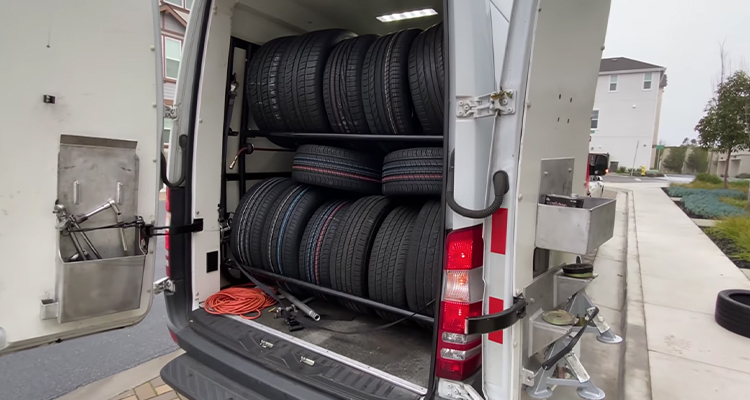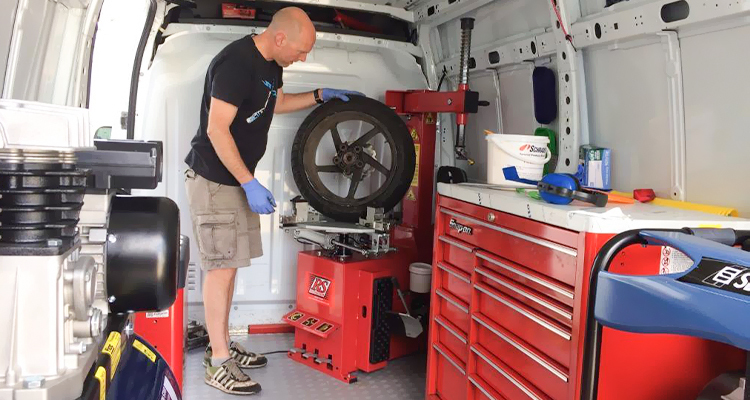Trusted Mobile Tire Service Las Vegas - On-Time Solutions
Trusted Mobile Tire Service Las Vegas - On-Time Solutions
Blog Article
Tire Solution: Proven Methods for Optimal Tire Upkeep and Care
Maintaining optimal tire condition is vital for both safety and performance of any kind of automobile. From making sure proper tire stress to regular rotation and alignment, there are tested techniques that can significantly prolong the life-span of your tires and enhance overall driving experience. As we check out the details of tire treatment and upkeep, we will certainly reveal vital guidelines that every automobile proprietor need to adhere to for the very best feasible results. Let's delve right into the globe of tire service and discover the keys to maintaining your tires in excellent form for the long haul.
Relevance of Tire Stress
Appropriate tire pressure is an essential consider guaranteeing optimal lorry efficiency and safety when traveling. Maintaining the recommended tire stress degrees provided by the supplier offers various benefits. Ample tire stress advertises far better gas effectiveness, as under-inflated tires can lead to raised rolling resistance, causing the engine to work more challenging and eat even more gas. Appropriate tire pressure makes sure also step wear, enhancing tire longevity and conserving cash in the long run by delaying the requirement for early substitutes. In addition, appropriately blew up tires add to boosted handling and braking abilities, crucial for safe driving in numerous roadway problems. Over-inflated tires, on the other hand, can result in reduced traction and a harsher ride. On the other hand, under-inflated tires are susceptible to getting too hot, which can cause blowouts and accidents. Consistently examining and readjusting tire pressure, especially previously long trips, is a basic yet efficient way to boost automobile performance, prolong tire lifespan, and focus on safety on the road.
Tire Turning Guidelines
When taking into consideration tire rotation guidelines, it is important to comprehend the value of this maintenance task in maximizing tire life-span and preserving optimum lorry performance. Tire rotation includes transforming the placement of each tire on an automobile to guarantee also step wear. Front tires tend to wear faster than back tires due to steering forces, making normal turning critical for balanced wear patterns. The recommended rotation pattern differs depending upon whether a car is front-wheel, rear-wheel, all-wheel, or 4x4. Normally, tires must be revolved every 5,000 to 7,500 miles, or as encouraged in the lorry handbook. Ignoring tire rotation can result in uneven wear, affecting handling, traction, and possibly compromising automobile safety. By adhering to proper rotation standards, drivers can expand the life of their tires, enhance fuel efficiency, and enhance total driving experience. Routine turning is a simple yet effective maintenance method that contributes dramatically to tire longevity and vehicle efficiency.

Benefits of Wheel Placement
Guaranteeing appropriate wheel alignment after tire rotation is crucial for preserving balanced wear patterns and making the most of car performance. Furthermore, proper wheel placement helps to expand the life-span of your tires. Misaligned wheels can cause unequal tire wear, leading to early tire substitute and boosted maintenance expenses.

Tire Tread Deepness Check
Carrying out a normal evaluation of tire walk deepness is vital for keeping secure driving problems and prolonging the life-span of your tires. Irregular tread look at more info wear can show problems with tire placement, pressure, or suspension, highlighting the importance of routine step depth checks. By integrating tire step depth checks right into your routine upkeep schedule, you can drive with self-confidence understanding that your tires are in top condition.
Seasonal Tire Examination
Seasonal tire examination is a basic facet of tire maintenance that ensures tires are all set to encounter the difficulties postured by various weather condition conditions. In prep work for winter, it is important to check the tire pressure routinely as cool temperature levels can cause tire pressure to go down. By conducting regular seasonal tire evaluations, chauffeurs can extend tire life-span, improve fuel performance, and most notably, make sure a safe driving experience in differing weather problems.
Verdict
To conclude, maintaining correct tire pressure, turning tires routinely, aligning wheels properly, keeping track of walk depth, and performing seasonal examinations are important techniques for ideal tire care. By following these confirmed methods, motorists can guarantee their tires last much longer, perform better, and contribute click over here to total car safety and security. It is essential to focus on tire upkeep to stop accidents, boost fuel performance, and lengthen the life-span of tires.
Appropriate tire pressure promotes better gas efficiency, as under-inflated tires can lead to enhanced rolling resistance, causing the engine to work more difficult and take in even more gas.When taking into consideration tire rotation standards, it is vital to understand the value of this maintenance job in taking full advantage of tire life expectancy and preserving optimal vehicle efficiency. Seasonal tire assessment is an essential aspect of tire maintenance that ensures tires are prepared to face the difficulties posed by various climate conditions. By performing regular seasonal tire inspections, vehicle drivers can lengthen tire lifespan, boost gas efficiency, and most notably, ensure a secure driving experience in differing climate problems.
In conclusion, keeping appropriate tire stress, turning tires routinely, lining up wheels properly, monitoring tread depth, and carrying out seasonal assessments are important techniques for optimal tire care.
Report this page